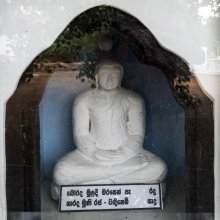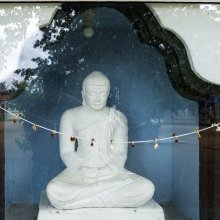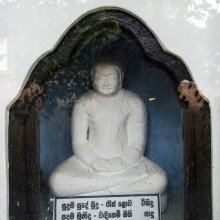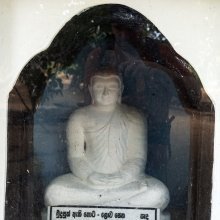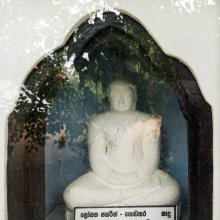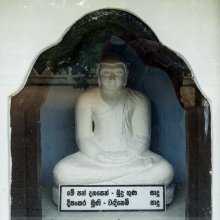Seven Buddhas: 3 definitions
Introduction:
Seven Buddhas means something in Buddhism, Pali, the history of ancient India. If you want to know the exact meaning, history, etymology or English translation of this term then check out the descriptions on this page. Add your comment or reference to a book if you want to contribute to this summary article.
Images (photo gallery)
(+18 more images available)
In Buddhism
General definition (in Buddhism)
Source: Wisdom Library: Dharma-samgrahaSeven Buddhas:—A technical term in Buddhism corresponding to the Sanskrit saptatathāgata defined in the Dharma-saṃgraha (section 6):
- Vipaśyī,
- Śikhī,
- Viśvabhū,
- Krakucchanda,
- Kanakamuni,
- Kāśyapa,
- Śākyamuni.
The Dharma-samgraha (Dharmasangraha) is an extensive glossary of Buddhist technical terms in Sanskrit (e.g., saptatathāgata, ‘seven Buddhas’). The work is attributed to Nagarguna who lived around the 2nd century A.D.
Source: WikiPedia: BuddhismAccording to Buddhist tradition, each kalpa has 1,000 Buddhas. The previous kalpa was the vyuhakalpa (Glorious aeon), and the present kalpa is called the bhadrakalpa (Auspicious aeon). The Seven Buddhas of Antiquity (Saptatathāgata) are seven Buddhas which bridge the vyuhakalpa and the bhadrakalpa:
- Vipassī (the 998th Buddha of the vyuhakalpa)
- Sikhī (the 999th Buddha of the vyuhakalpa)
- Vessabhū (the 1000th and final Buddha of the vyuhakalpa)
- Kakusandha (the first Buddha of the bhadrakalpa)
- Koṇāgamana (the second Buddha of the bhadrakalpa)
- Kassapa (the third Buddha of the bhadrakalpa)
- Gautama (the fourth and present Buddha of the bhadrakalpa)
Following the Seven Buddhas of Antiquity will be Maitreya, the fifth and future Buddha of the bhadrakalpa.
India history and geography
Source: academia.edu: History of Nepalese Buddhism: From Mythological Tradition to the Lichhavi PeriodThe concept of the Seven Buddhas (Saptatathagata) according to the Svayambhu Purana:
- Vipassi,
- Sikhi,
- Vishwabhu,
- Krakuchanda,
- Kanakmuni,
- Kashyapa and
- Shakyamuni.
The primordial Buddha or the Svayambhu (the self sprouted) is highly venerated in the Buddhist society of Nepal. Nepalese Buddhists not only venerate the Seven Buddhas, but also the text of the Svayambhu Purana itself. The names of the Seven Buddhas mentioned in the Purana are identical to the names mentioned in the Buddhavamsha . The existence of some of the seven Buddhas has been archaeologically proved. Huen-Tsang, a famous Chinese traveller also saw Chaityas erected in the memory of Kashyapa, Kanakmuni and Kakruchhanda Buddha. His account obviously proved the existence of the Buddhas in different epochs before that of the historical Buddha. The account is not myth but the historical fact. The Ashokan pillar of Lumbini also mentions the Kanakmuni and Kakruchhanda Buddhas. It proves the existence of the Buddhas in different epochs before the historical Buddha.

The history of India traces the identification of countries, villages, towns and other regions of India, as well as mythology, zoology, royal dynasties, rulers, tribes, local festivities and traditions and regional languages. Ancient India enjoyed religious freedom and encourages the path of Dharma, a concept common to Buddhism, Hinduism, and Jainism.
See also (Relevant definitions)
Full-text (+11): Vishvabhu, Kashyapa, Sakyamuni, Kanakamuni, Krakucchanda, Vipashyin, Vipashyi, Shikhi, Saptatathagata, Anupapadaka, Mahapadana Sutta, Kurandaka, Svastika, Kshemakara, Krakasunda, Sarvamitra, Vishvabhuj, Upasthayaka, Bhadrika, Buddhagotra.
Relevant text
Search found 15 books and stories containing Seven Buddhas; (plurals include: Seven Buddhases). You can also click to the full overview containing English textual excerpts. Below are direct links for the most relevant articles:
The Jataka tales [English], Volume 1-6 (by Robert Chalmers)
Jataka 203: Khandha-Vatta-jātaka < [Book II - Dukanipāta]
The Catu-Bhanavara-Pali (critical study) (by Moumita Dutta Banik)
(10) Khandhaparitta Sutta < [Chapter 2 - Subject Matter of the First Bhanavara]
Importance of Atanatiya sutta < [Chapter 5 - Subject Matter of the Fourth Bhanavara]
The Great Chronicle of Buddhas (by Ven. Mingun Sayadaw)
The Story of Venerable Cittagutta < [Chapter 6 - On Pāramitā]
Part 1 - The story of Setaketu Deva, the future Buddha < [Chapter 1 - The Jewel of the Buddha]
Part 1 - The Āṭānāṭiya Paritta < [Chapter 39 - How the Āṭānāṭiya Paritta came to be Taught]
Vinaya (3): The Cullavagga (by T. W. Rhys Davids)
Cullavagga, Khandaka 5, Chapter 6 < [Khandaka 5 - On the Daily Life of the Bhikkhus]
Maha Prajnaparamita Sastra (by Gelongma Karma Migme Chödrön)
Appendix 7 - The Buddha’s assistants (upasthāyaka) < [Chapter XLI - The Eighteen Special Attributes of the Buddha]
Bhūmi 9: the ground of good wisdom (sādhumatī) < [Chapter XX - (2nd series): Setting out on the Mahāyāna]
Act 9.2: Examination of the plurality of Buddha < [Chapter XV - The Arrival of the Bodhisattvas of the Ten Directions]
Buddhist records of the Western world (Xuanzang) (by Samuel Beal)
Chapter 5 - Country of Mo-la-p’o (Malava) < [Book XI - Twenty-three Countries]
